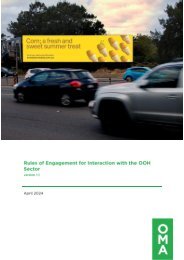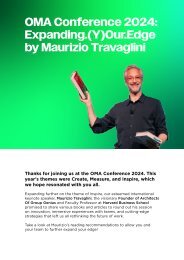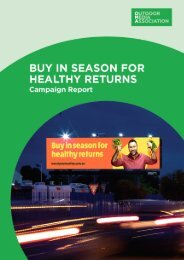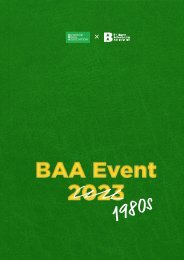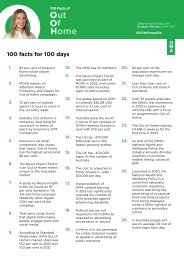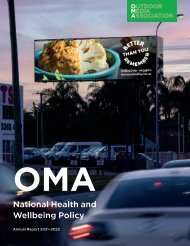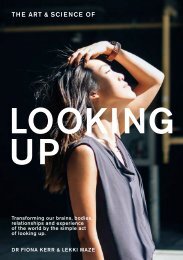OPEN 2
The OPEN series was born from the desire to create a forum for applauding and interrogating strong creative design within the Out of Home (OOH) industry. Illustrating how OOH is part of our cityscape, our commute, our weekend and our shopping and holiday experiences, OOH is ‘the original tweet’ and it cannot be switched off, ignored or fast forwarded. Big, bold, cheeky, simple, clever and controversial, OOH is the ultimate creative stage, allowing brands to be unique, contextually relevant and targeted while reaching mass audiences.
The OPEN series was born from the desire to create a forum for applauding and interrogating strong creative design within the Out of Home (OOH) industry. Illustrating how OOH is part of our cityscape, our commute, our weekend and our shopping and holiday experiences, OOH is ‘the original tweet’ and it cannot be switched off, ignored or fast forwarded. Big, bold, cheeky, simple, clever and controversial, OOH is the ultimate creative stage, allowing brands to be unique, contextually relevant and targeted while reaching mass audiences.
Create successful ePaper yourself
Turn your PDF publications into a flip-book with our unique Google optimized e-Paper software.
INTERACT WITH ME<br />
John Purcell, Commercial Director,<br />
Operations & Business Systems, oOh! Media<br />
...<br />
“Don’t just talk to me, interact with me!” is<br />
something that consumers are increasingly<br />
demanding of brands.<br />
With the rapid introduction of digital<br />
technology and innovation, Out-of-Home<br />
(OOH) advertising has led the way in bridging<br />
the connection between brands and the<br />
consumer. No longer do marketers use OOH<br />
solely to gain a large brand presence. OOH<br />
is now also able to deliver unprecedented<br />
interaction between consumers and their<br />
brands while they are away from home.<br />
In recent years, we have seen some<br />
of the world’s leading brands embrace the<br />
new OOH offerings to engage with consumers<br />
on an unparalleled level. Take, for example,<br />
Google, HP and Microsoft who are increasingly<br />
becoming bigger spenders in OOH. Why?<br />
Because they seek to engage consumers with<br />
innovations that match their brand’s positioning<br />
and benefit from the two-way communication<br />
that continues well beyond their first contact<br />
with the OOH advertising face.<br />
Last year, Google ran an OOH advertising<br />
campaign in airports where consumers could<br />
take control of the digital advertising panels<br />
utilising NFC and QR technologies. In this<br />
world-first campaign, travellers used their<br />
smartphone or tablet to interact with the<br />
Google Play store via the digital advertising<br />
panels (p. 140), accessing content across several<br />
genres such as Tweens, Professionals, High<br />
Octane and Kids. Android phone users could<br />
download selected books, movies, music,<br />
magazines or apps directly to their phone<br />
using the OOH provider’s free airport WiFi.<br />
But OOH’s interaction potential does<br />
not stop with what’s accessible via our<br />
telephones or tablets using QR and NFC<br />
technology. We have seen a range of other<br />
innovations across all OOH assets that take<br />
the connection between brands and<br />
consumers beyond brand building to deep<br />
engagement.<br />
In shopping centres, the industry has<br />
seen the introduction of technologies that<br />
generate greater connection through sound<br />
and scent. We have also introduced ‘digital<br />
targeting’ technology that makes messages<br />
more relevant and engaging based on factors<br />
such as time of day or temperature. And<br />
we have seen the introduction of advertising<br />
panels that dispense products, vouchers<br />
or information to the consumer.<br />
One of the best examples of the level<br />
of interaction the dispensing units generate<br />
is a campaign by Meat & Livestock Australia<br />
(pp. 152–153) where recipes were dispensed<br />
to consumers with the push of a button. This<br />
campaign, which distributed more than<br />
20,000 recipes per month from 10 panels,<br />
is a classic example of how engagement drives<br />
sales: shoppers gained cooking inspiration from<br />
the panels, and then purchased the ingredients<br />
they needed.<br />
We are also seeing greater engagement<br />
with people for both static and digital<br />
billboards via integration with social<br />
media channels, where OOH drives social<br />
conversation and vice versa. While still in<br />
its early days, we have helped clients integrate<br />
the most traditional media with new media<br />
to amplify campaigns beyond what either<br />
medium could otherwise offer.<br />
One example of how social media can<br />
integrate well with OOH is Virgin Mobile’s<br />
recent Game of phones campaign (p. 158).<br />
A purpose-built dynamic messaging platform<br />
developed by the OOH provider enabled<br />
Virgin Mobile to send real-time messages to<br />
the participants on the digital network which<br />
helped drive social gameplay and conversation.<br />
Another example saw the rollout of interactive<br />
touchscreen technology that allowed passers-<br />
147 /



